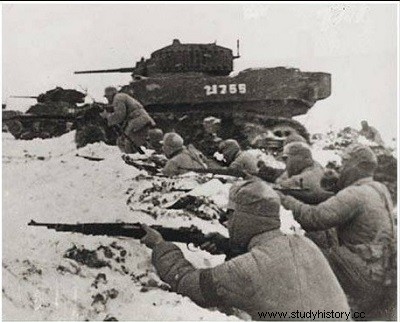
With the front now gaping open, the Chinese rushed south, threatening to surround the entire United Nations troops retreating towards the Chongchon River. On November 28, the Eighth Army, pushed southward at an increasingly rapid pace, was hampered in its retreat by bands of terrified refugees who were joining it. On December 5, North Korea's capital, Pyongyang, had to be evacuated, and on December 13, United Nations forces reached the Imjin River, having retreated 190 km in 10 days.
They now prepared to hold their front line on the 38th parallel. Fortunately for them, the Chinese momentum was weakening for lack of sufficient food. The Chinese stopped in Pyongyang to requisition all kinds of vehicles for their next advance:everything was good for them, carts, wheelbarrows, oxen and pack horses.
In the northeast, the situation for United Nations forces was almost as dire as in the northwest. The Chinese threw 12,000 men against the Marines of the 10th Corps, attacking suddenly and massively in suicidal waves. The night fights raged in the villages:it was an unprecedented carnage. The redou
Korean winter table, with its temperatures of - 18°, made the American rifles unusable but the Browning machine guns remained operational.
The relentless cold also claimed many victims. After 30 November, when General MacArthur received the order to withdraw the 10th Corps, several Allied soldiers, insufficiently covered, died of cold during the long and perilous retreat towards the embarkation port of Hungnam.
Hungnam, transformed into a solid bridgehead, withstood the repeated attacks of the Chinese. But his safety threatened that of more than half of the troops of the 7th Infantry Division trapped in the Chosin Reservoir area; of the 1,000 men who managed to fight their way to Hagaru, at the southern tip of the Reservoir, on December 2, 615 were incapacitated.
In Hagaru, just a few meters from the scene of bloody pitched battles, American engineers bulldozed an airstrip into hard-as-iron earth by searchlight. The Dakotas who later landed there evacuated more than 4,500 wounded to Hungnam.
Within the next few days, the retreat of the columns of soldiers and vehicles was hampered by the Chinese who did not lose an opportunity to harass them. One of them took 38 hours to cover 18 kilometers.
The evacuation by sea from Hungnam and the port of Wonsan, 80 kilometers to the south on the east coast, ended on December 24. Some 105,000 men and 98,000 refugees as well as 17,500 vehicles, 350,000 tons of ammunition and food were thus transported south to Pusan. An airlift of 3,600 men, 200 vehicles and 1,300 tons of cargo also worked.
